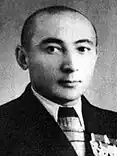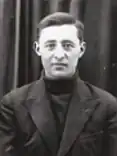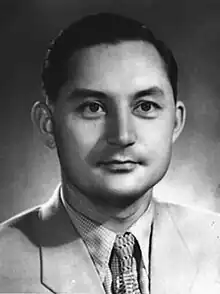East Turkestan Revolutionary Party | |
|---|---|
| Chairman | Abdulkerim Abbas |
| Founded | 26 April 1946 |
| Dissolved | 3 February 1947 |
| Merged into | Democratic Revolutionary Party |
| Headquarters | Ghulja (Yining) |
| Youth wing | East Turkestan Revolutionary Youth League |
| Ideology | |
| Political position | Far-left |
The East Turkestan Revolutionary Party (ETRP)[lower-alpha 1] was a clandestine communist party active from 1946 to 1947, in what is now Ili Kazakh Autonomous Prefecture, in the Xinjiang Uyghur Autonomous Region of China. Abdulkerim Abbas, a Uyghur revolutionary who served as the interior minister of the Second East Turkestan Republic (ETR), led the party as chairman of a seven-member central executive committee.
The ETRP emerged from the more moderate East Turkestan Revolutionary Youth League (ETRYL), a group of young, progressive-minded intellectuals who opposed the conservative faction of the ETR government. Many party members came from the ETRYL, and the ETRYL later became the party's youth wing. Marxist–Leninist in its orientation, the ETRP's constitution, program, and organisational structure drew from those of the Soviet and Chinese communist parties.
Names
| East Turkestan Revolutionary Party | |||||||||
|---|---|---|---|---|---|---|---|---|---|
| Uyghur name | |||||||||
| Uyghur | شەرقىي تۈركىستان ئىنقىلاۋى پارتىيىسى | ||||||||
| |||||||||
| Russian name | |||||||||
| Russian | Революционная партия Восточного Туркестана | ||||||||
| Romanization | Revolyutsionnaya partiya Vostochnogo Turkestana | ||||||||
| Chinese name | |||||||||
| Simplified Chinese | 东突厥斯坦革命党 | ||||||||
| Traditional Chinese | 東突厥斯坦革命黨 | ||||||||
| |||||||||
| People's Revolutionary Party | |||||||||
| Simplified Chinese | 人民革命党 | ||||||||
| Traditional Chinese | 人民革命黨 | ||||||||
| |||||||||
| Three Districts People's Revolutionary Party | |||||||||
| Simplified Chinese | 三区人民革命党 | ||||||||
| Traditional Chinese | 三區人民革命黨 | ||||||||
| |||||||||
| Xinjiang People's Revolutionary Party | |||||||||
| Simplified Chinese | 新疆人民革命党 | ||||||||
| Traditional Chinese | 新疆人民革命黨 | ||||||||
| |||||||||
Sources differ as to the official name of the party, but Abbas' handwritten copy of the party constitution is titled "Constitution of the East Turkestan Revolutionary Party".[lower-alpha 2][1] The first chapter of the constitution, titled "On the Name of the Party", further states:
Our party is established with a base of the most progressive intellectuals; in line with the international situation at present and East Turkestan's current stage of historical development, the name of the party shall be set as the East Turkestan Revolutionary Party.[1]
Chinese sources generally describe the party as the People's Revolutionary Party.[lower-alpha 3] The names Three Districts People's Revolutionary Party[lower-alpha 4] and Xinjiang People's Revolutionary Party[lower-alpha 5] are sometimes used to differentiate from the similarly named East Turkestan People's Revolutionary Party of the 1960s and 1970s.[2]
Prior to the party's founding, the Soviet leadership in Moscow suggested to Abbas and his Soviet contacts that the party be named the People's Party of Xinjiang, as such a name would appeal to all ethnic groups in Xinjiang (particularly the Han Chinese) and appease the Chinese authorities. The latter reason was particularly important to Moscow, which hoped to improve Sino-Soviet relations while maintaining influence in Xinjiang. Abbas rejected the proposal.[3]
History
Background
The East Turkestan Revolutionary Party (ETRP) was active in the "Three Districts" – Ili, Tarbaghatay, and Altay – when the region was governed by the Second East Turkestan Republic (ETR). The ETR was proclaimed on 12 November 1944, following successful uprisings in the Three Districts, particularly in the city of Ghulja (Yining), which became the ETR's capital.[4] The uprisings came to be known collectively as the Ili Rebellion. The ETR government consisted of Turkic intellectuals of various ideologies and political goals. The leadership was dominated by religious conservatives, who viewed the rebellion as a war of national liberation to restore the First East Turkestan Republic which had been founded exactly eleven years earlier.[4] Soviet-educated progressives within the leadership viewed the rebellion as an anti-imperialist revolution against the Kuomintang (Chinese Nationalists).[5] The latter view held by the progressives was supported by the Chinese Communist Party (CCP), which called the rebellion the "Three Districts Revolution".[lower-alpha 6][6]
The Soviet Union covertly backed the rebels and supported the ETR, which was receptive to Soviet interests in the region.[7] However, at the same time, the Soviets did not wish to antagonise its wartime ally China. The Soviet leadership overlooked the fact that the ruling party of China at the time, the Kuomintang, was anti-communist; they hoped to create cordial relations with the Kuomintang to ensure postwar security along their shared borders.[8] As such, the Soviets were careful not to openly support communists in the region during the time of the ETR, which would make their negotiation efforts with the Kuomintang appear disingenuous.[9][10]
Origins and founding
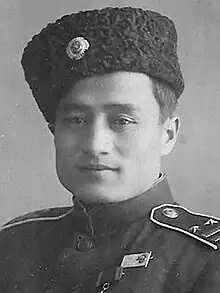
The ETRP's origins can be traced to the East Turkestan Revolutionary Youth League (ETRYL), which was founded by disgruntled members of the ETR government. A group of young, progressive-minded intellectuals within the government opposed the presidency of Elihan Tore, who headed the government's conservative leadership.[11] In November 1945, they formed the ETRYL, the leadership of which consisted of the progressive faction of the ETR government headed by Abbas.[5] However, not all progressive leaders of the ETR were involved in the ETRYL's founding; most significantly, the pro-Soviet foreign minister Ehmetjan Qasim was preoccupied with peace negotiations with the Kuomintang.[12] The ETRYL quickly gained support amongst Soviet- and Chinese-educated youth; in a matter of weeks, its membership ballooned to 14,000, spread over 27 counties of the Three Districts.[13]
At its onset, the ETRYL was not ideological; it advocated an ethnically inclusive form of civic nationalism and centered its platform on a narrow set of issues, chiefly opposition to the Kuomintang.[5] However, members of the ETRYL's central committee, particularly Abbas, felt that it was necessary to establish a vanguard party to guide the ETRYL toward revolutionary action.[14] Anwar Hanbaba, an ETRYL central committee member, described in his memoirs the then necessity of a vanguard party:
In human societies of every epoch, the training of youths and the grooming of successors have been important matters, and the Three Districts Revolution was no different in this regard. In order to meet these important tasks, the provisional government and peoples of the Three Districts needed to train, organize, and utilize the youthful energy of the young people to ... consolidate, unite, and galvanise them in the fight against the Kuomintang reactionaries.[15]
Sources differ as to when the ETRP was founded. Saifuddin Azizi, another ETRYL central committee member, wrote in his memoirs that the ETRP was founded in December 1945. This is repeated in Xinjiang's Local History, the Chinese government-approved textbook used in Xinjiang's secondary schools.[16] Party records published by the ETRP's successor, the Democratic Revolutionary Party, give the date 26 April 1946.[1] Hanbaba meanwhile stated that the party was founded on 5 May 1946.[17]
The ETRP was founded with the blessing of the Soviet leadership, with whom Abbas consulted when drafting the party's program and organisational framework.[18] The party modelled itself after the Communist Party of the Soviet Union (CPSU),[lower-alpha 7] with adjustments to account for the material conditions of Xinjiang.[19] The ETYRL became the party's youth wing.[14] A seven-member central executive committee (CEC) was elected with Abbas serving as its chair.[14][20] Other members of the CEC were unaware of Abbas' communications with the Soviets. For example, Azizi incorrectly believed that the ETRP's existence had been kept secret from the Soviets to avoid their interference.[21]
Communications with the Chinese Communist Party
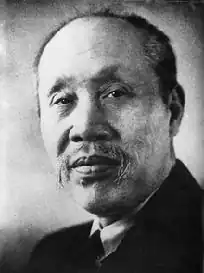
In December 1946, Abbas travelled to the then Chinese capital Nanjing, ostensibly to attend a session of the Chinese National Assembly as a delegate from Xinjiang.[22] In actuality, he was attempting to establish contact with the CCP to ask for help in starting a second revolution in Xinjiang, in the same vein as the October Revolution in Russia.[23][24] Dong Biwu, a CCP delegate from Yan'an, secretly met with Abbas in Nanjing. Abbas explained to Dong that the ETRP had been working closely with the Han Chinese-majority Communist League of Xinjiang headquartered in Dihua (Ürümqi), and that together they numbered in the tens-of-thousands. Both groups hoped to integrate their membership into the CPSU, but the Soviet leadership had not yet received their request. Abbas therefore reached out to the CCP for its support.[24] Dong immediately relayed this information back to the CCP central committee in Yan'an via telegraph and scheduled a second meeting with Abbas.[25]
At their second meeting, Dong provided Abbas documents from the CCP's 7th National Congress and the opinions of the CCP leadership. Dong extended the warm greetings of Zhou Enlai, the vice chairman of the military commission of the central committee. Zhou agreed in principle to CCP membership for leaders of the ETRP and Communist League. However, Zhou also relayed the CCP central committee's opinion that the ETRP's name was "inappropriate" as it implied support for an independent East Turkestan. Abbas responded by agreeing in principle to table the "Xinjiang national question".[26] Before Abbas left to return to Ghulja, Dong gave him radio equipment for the ETRP to contact the CCP with. The radio, however, was not sufficiently powerful to reach Yan'an from Ghulja and the two communist groups could not establish regular communication.[26]
Dissolution
Abbas returned to Ghulja in early 1947 and immediately made arrangements to meet with the leaders of the Communist League. On 3 February 1947, the leaders of the ETRP and the Communist League met in Dihua. Abbas informed the attendees of the CCP central committee's opinions and recommendations, and the two groups agreed to a CCP-recommended merger. The dissolution of both groups and the formation of the Democratic Revolutionary Party were declared later that day.[27][28]
Ideology and program
The ETRP's program was reviewed and edited by the Soviets before its founding.[18][29] In late 1945, a draft party program, approved by Abbas, was submitted to the Soviet leadership in Moscow by Usman Yusupov, the first secretary of the Communist Party of Uzbekistan (Bolsheviks). The Soviet ministries of interior and state security wrote their own draft and submitted it to Mikhail Suslov, the head of the foreign policy department of the All-Union Communist Party (Bolsheviks). After reading and comparing the two drafts, Suslov sent an amended version to the Soviet party secretary for ideology, Andrei Zhdanov.[30] Owing to the Soviets' wishes to not further antagonise the Chinese, Suslov's draft included sentences which clarified that the ETRP's request for internal autonomy in Xinjiang would not deny China's claims of sovereignty over the region, and that the ETRP would "support all progressive measures of the government of the Republic of China."[3]
The ETRP was founded with the goal of becoming a vanguard party for the masses of Xinjiang, particularly the youth through the ETRYL. Article 8 of the ETRP's constitution stated that the party's purpose was to "raise the youth to become fighters, patriots, and internationalists."[14] The ETRP's founders felt that the ETRYL, as an above-ground organisation, was too moderate and hindered by the constant interference of the ETR's conservative leadership. The foundation of an underground, strictly Marxist–Leninist organisation would therefore serve to guide future revolutionary action in a socialist direction, in contrast to the non-ideological, civic nationalist platform of the ETRYL.[31][32] The constitution of the ETRP drew from the CCP constitution at the time, particularly Mao Zedong's concept of "New Democracy".[33]
Central executive committee
The ETRP's central executive committee (CEC) consisted of seven members: Abdulkerim Abbas, Seydulla Seypulla, Saifuddin Azizi, Asgat Iskhakov, Muhemmetimin Imin, Anwar Hanbaba, and Abdulla Zakir.[14] Five of them were also members of the ETRYL's central committee.[14] The CEC was multiethnic; five members were Uyghur, one Tatar (Iskhakov), and another Uzbek (Hanbaba).[34] CEC members referred to each other by Uyghur-language code names, the initials of which spelled out the word Lëninchi, meaning "Leninist".[20][33] Abbas led the CEC as chairman.[14]
| Member | Code name | Position |
|---|---|---|
| Abdulkerim Abbas | Lutfi | Chairman |
| Seydulla Seypulla | Ëldan | Minister for Rural Areas |
| Saifuddin Azizi | Nur | Minister of Communication |
| Asgat Iskhakov | Ijat | Minister of Organisation |
| Muhemmetimin Imin | Nijat | Minister of Military Affairs |
| Anwar Hanbaba | Cholpan | Minister of Commerce |
| Abdulla Zakir | Ilghar | Secretary-General |
Notes
- ↑
- ↑ Uyghur: شەرقىي تۈركىستان ئىنقىلاۋى پارتىيىسى نىزامنامىسى, romanized: Sherqiy Türkistan Inqilawi Partiyisi Nizamnamisi
- ↑ Chinese: 人民革命党; pinyin: Rénmín Gémìng Dǎng
- ↑ Chinese: 三区人民革命党; pinyin: Sān Qū Rénmín Gémìng Dǎng
- ↑ Chinese: 新疆人民革命党; pinyin: Xīnjiāng Rénmín Gémìng Dǎng
- ↑ Chinese: 三区革命; pinyin: Sān Qū Gémìng
- ↑ Then known as the All-Union Communist Party (Bolsheviks).
References
Citations
- 1 2 3 Wang 2020, p. 240.
- ↑ Brophy 2023, p. 904.
- 1 2 Hasanli 2020, p. 189.
- 1 2 Evans 2017, p. 53.
- 1 2 3 Evans 2017, p. 68.
- ↑ Evans 2017, p. 2.
- ↑ Hasanli 2020, p. 125.
- ↑ Hasanli 2020, p. 123.
- ↑ Wang 2020, p. 243.
- ↑ Evans 2017, pp. 69–70.
- ↑ Evans 2017, p. 66.
- ↑ Wang 2020, p. 239.
- ↑ Evans 2017, p. 69.
- 1 2 3 4 5 6 7 Wang 2020, p. 241.
- ↑ Evans 2017, p. 68, citing Hanbaba 1999, p. 19.
- ↑ Evans 2017, p. 70.
- ↑ Hanbaba 1999, p. 25.
- 1 2 Hasanli 2020, pp. 188–189.
- ↑ Evans 2017, p. 71.
- 1 2 Evans 2017, pp. 70–71.
- ↑ Brophy 2021, p. 240.
- ↑ Benson 1990, p. 97.
- ↑ Shih 2015, p. 154.
- 1 2 CCP History Archives 1998, p. 105.
- ↑ CCP History Archives 1998, pp. 105–106.
- 1 2 CCP History Archives 1998, p. 106.
- ↑ Chen 2006, pp. 112–113.
- ↑ Zhang 2003, p. 458.
- ↑ Brophy 2021, pp. 240–241.
- ↑ Hasanli 2020, p. 188.
- ↑ Wang 2020, pp. 242, 354–356.
- ↑ Evans 2017, pp. 67–68.
- 1 2 Wang 2020, p. 242.
- ↑ Wang 2020, p. 235.
Sources
Books
- Azizi, Saifuddin (December 1987). 天山雄鹰——阿布杜克力木·阿巴索夫生平 [The Eagle of Tengri Tagh – The Life of Abdulkerim Abbas] (PDF) (in Chinese). Chinese Literature and History Press. ISBN 9787503400254. Archived (PDF) from the original on 2023-12-17. Retrieved 2024-01-04.
- Benson, Linda (1990). The Ili Rebellion: the Moslem challenge to Chinese authority in Xinjiang, 1944–1949. M.E. Sharpe. ISBN 0-87332-509-5.
- Brophy, David (30 September 2023). A Decade in Sino-Soviet Diplomacy: The Diaries of Liu Zerong, 1940–49. Springer Nature. ISBN 978-981-99-4082-0.
- Chen, Guoyu, ed. (2006). 为了新疆解放 [For the Liberation of Xinjiang] (in Chinese). Xinjiang People's Publishing House. ISBN 978-7-228-10012-5.
- Hanbaba, Anwar (1999). ئۈچ ۋىلايەت ئىنقىلابى دەۋرىدىكى پارتىيە-تەشكىلاتلار [Parties and Organizations during the Three Districts Era]. شىنجاڭ تارىخ ماتېرىياللىرى [Xinjiang Historical Materials] (in Uyghur). Vol. 42. Xinjiang People's Publishing House. ISBN 978-7-228-04377-4.
- Hasanli, Jamil (3 December 2020). Soviet Policy in Xinjiang: Stalin and the National Movement in Eastern Turkistan. Rowman & Littlefield. ISBN 978-1-7936-4127-4. Archived from the original on 29 December 2023. Retrieved 30 December 2023.
- Wang, Ke (15 March 2020). The East Turkestan Independence Movement, 1930s to 1940s. Translated by Fletcher, Carissa. The Chinese University of Hong Kong Press. ISBN 978-962-996-769-7.
- Zhang, Zhenjie, ed. (2003). 伊宁县志 [Yining County Chronicle] (in Chinese). Xinjiang People's Publishing House. ISBN 978-7-228-08486-9.
- 中共党史资料: 第六十七辑 [Information on the History of the Communist Party of China: Issue 67] (in Chinese). Party History Research Office of the Central Committee of the Chinese Communist Party. 1998. ISBN 978-7-80136-188-2.
Journal articles and dissertations
- Brophy, David (1 January 2021), "The East Turkestan Independence Movement: 1930s–1940s, by Wang Ke; translated by Carissa Fletcher. Hong Kong: Chinese University Press, 2018. vii+361 pp. US$50.00 (cloth).", The China Journal (Book review), 85: 239–241, doi:10.1086/711540, ISSN 1324-9347
- Evans, Michael P. (July 2017). A Nearly Perfect Storm: The Rise and Fall of the Eastern Turkistan People's Revolutionary Party (PhD thesis). Indiana University ProQuest Dissertations Publishing.
- Shih, Chien-yu (1 December 2015). 蘇聯介入與現代維吾爾民族主義的興起:東突厥斯坦共和國不同史觀的討論 [Soviet Involvement and the Rise of Modern Uyghur Nationalism: A Discussion of Different Historical Views of the East Turkestan Republic]. Cultural Research (in Chinese (Taiwan)). National Yang Ming Chiao Tung University Press (21): 127–160. doi:10.6752/jcs.201512_(21).0005. ISSN 1816-0514. Archived from the original on 5 August 2023. Retrieved 4 January 2024.
- Xu, Jianying (November 2016). “东突” 问题的历史与现状述论 [A review of the history and current situation of the 'East Turkestan' issue] (PDF). Journal of Xinjiang Normal University (Philosophy and Social Sciences) (in Chinese). 37 (6): 1–10. doi:10.14100/j.cnki.65-1039/g4.2016.06.001. Archived (PDF) from the original on 2023-06-21. Retrieved 2024-01-04.
.jpg.webp)
